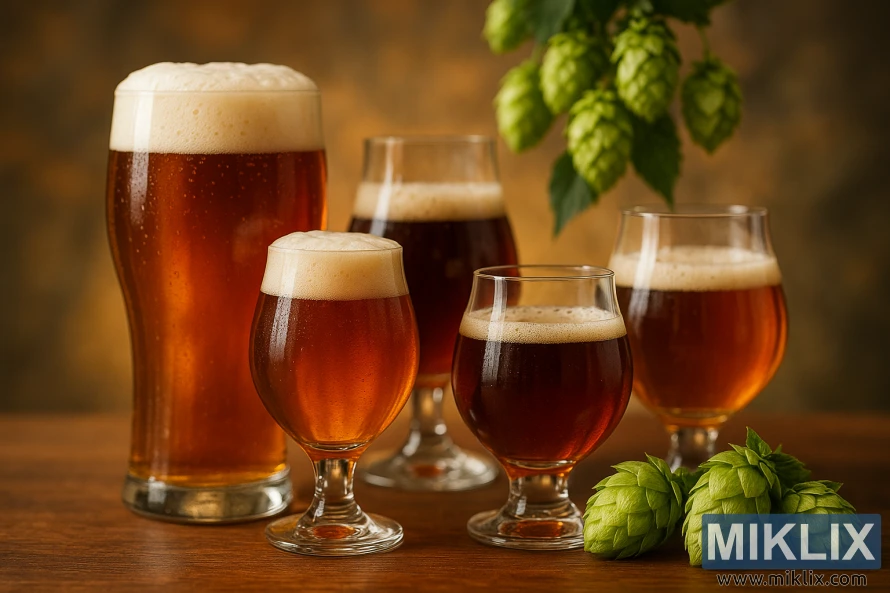Image: Pride of Ringwood Beer Styles
Published: August 18, 2025 at 7:45:50 AM UTC
Last updated: September 26, 2025 at 9:03:45 PM UTC
A still life of amber ales and specialty glasses surrounded by Pride of Ringwood hops, evoking the cozy ambiance of a brewery taproom.
The still life unfolds with a celebratory harmony of color, texture, and form, capturing the timeless interplay between hops and beer. At the center of the composition, five glasses of ale, each filled with a glowing amber liquid, stand as a testament to the versatility and expressive range of Pride of Ringwood hops. The tallest glass, a classic pint with a creamy cap of foam, anchors the scene with presence and balance, its condensation catching the warm golden light. Beside it, tulip-shaped and snifter glasses cradle their contents with elegance, their curved bowls enhancing both the visual depth of the beer and suggesting the sensory experience awaiting anyone who lifts them. Each vessel holds a slightly different shade of amber, from lighter honey-gold to deep russet, hinting at the diverse malt backbones and hop schedules that shape the individuality of each brew.
The beers are topped with modest, inviting heads of foam—pillowy, off-white, and flecked with tiny bubbles—that speak of freshness and carbonation. The way the light filters through the glasses accentuates the beers’ clarity and effervescence, the suspended bubbles catching glimmers of brightness against the warm backdrop. It is a scene that does not just depict beverages but radiates the promise of taste: the crisp bitterness, the resinous spice, the gentle citrus lift, and the earthy undercurrents that have long made Pride of Ringwood a distinctive force in brewing.
Framing this tableau are clusters of hop cones, both resting at the base of the glasses and hanging gracefully above. Their vivid green scales, rendered in intricate detail, contrast with the deep reddish tones of the ales, reminding the viewer of the raw agricultural origins of these refined drinks. The hops appear lush and almost tactile, their layered bracts catching soft highlights as if freshly picked. Their presence transforms the image from a simple arrangement of beer into a narrative of process—field to glass, cone to foam, nature to craft. They serve as both visual balance and symbolic anchor, emphasizing the essential role that hops play in defining aroma, flavor, and character.
The background is softly blurred, painted with warm, hazy browns and golds, creating a cozy, intimate atmosphere reminiscent of a rustic brewery taproom. This diffuse backdrop allows the glowing beers and bright hops to remain the stars, while also evoking the ambiance of wood, malt, and candlelight. There is a timeless quality to it, as though this could be a scene set decades ago or in a modern craft brewery celebrating its heritage.
Beyond its visual beauty, the composition communicates the philosophy of brewing itself—a union of science and art, agriculture and craftsmanship. The Pride of Ringwood hop, an iconic Australian variety, stands here not just as an ingredient but as a symbol of tradition, innovation, and cultural identity. Its bold, resinous bitterness and distinctive aroma once defined a brewing era, and in this scene, its enduring significance is immortalized. The beers before us are not simply drinks, but stories in liquid form, infused with the essence of the hop fields, the hands of brewers, and the anticipation of the drinker.
The image as a whole exudes warmth and celebration. It beckons the viewer not only to appreciate the aesthetic interplay of amber, gold, and green but to imagine lifting one of the glasses, inhaling the rich bouquet, and savoring the layered flavors born of humble cones now elevated to icons of brewing history.
The image is related to: Hops in Beer Brewing: Pride of Ringwood

